Insights from the Mobile World Congress 2018
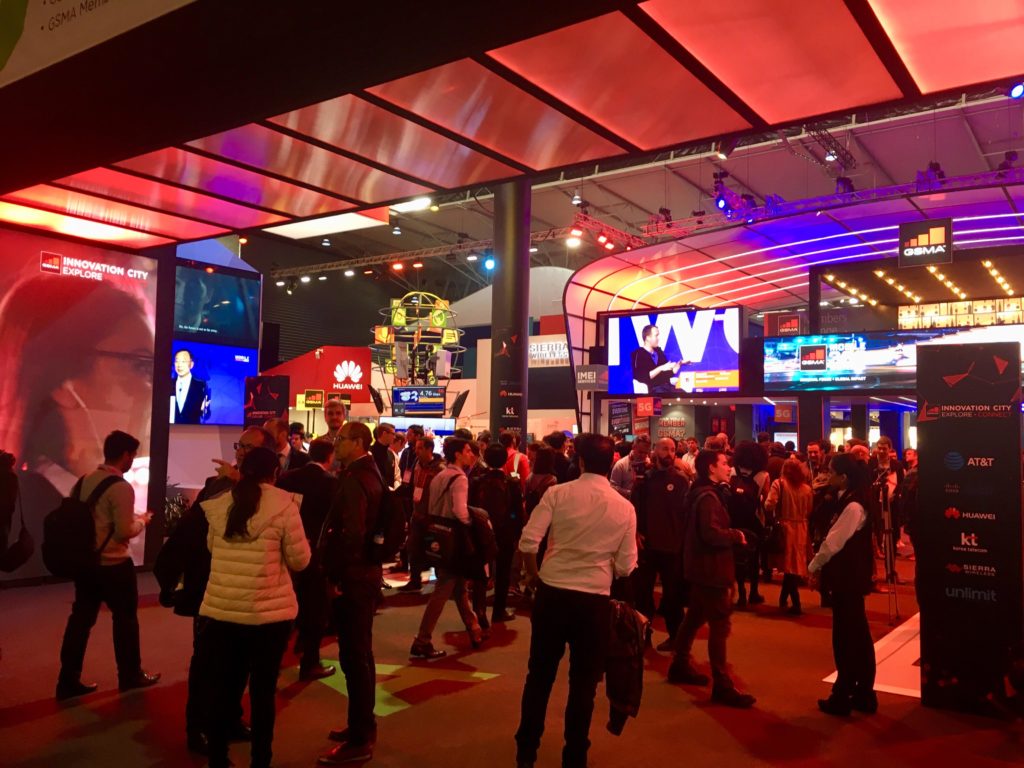
A few weeks ago I attended the Mobile World Congress – one of the biggest tech conferences in the world. I was interested to see what’s hot in tech now and I wanted to get some insights on the direction that technology is heading and how that technology may interact with and affect its human users. Below I’ll talk about some of my observations and then mention a couple of the things which I simply thought were cool.
Observations
 1. Security
1. Security
Security is big. Everywhere I turned, especially in the startup branch of the conference, there were cyber security companies. Security of personal data, financial transactions, sensitive company information, etc. And as the principle goes – wherever there’s supply, there must be demand. I wasn’t aware of how relevant the issue of online security was before I attended the conference and passed dozens of booths like those in the photo. So I began to wonder – what exactly is going on behind our screens? I doubt the majority of Internet users have any idea about the ripples that their online activities make and how far those ripples reach. After the MWC I started researching online security and the truth is pretty scary. In summary, every part of our uploaded lives is easy to access by hackers, our financial information is vulnerable to theft via numerous different methods, and a minuscule amount of Internet crimes are solved or culprits caught. That being said, effective Internet security is a hot field in tech right now and with good reason.
2. Personal digital assistants are becoming very realistic
This is one of the most interesting things I found, primarily because I’ve been skeptical that AI and robots can become truly life-like any time soon. Alas, I was wrong (surprise surprise).
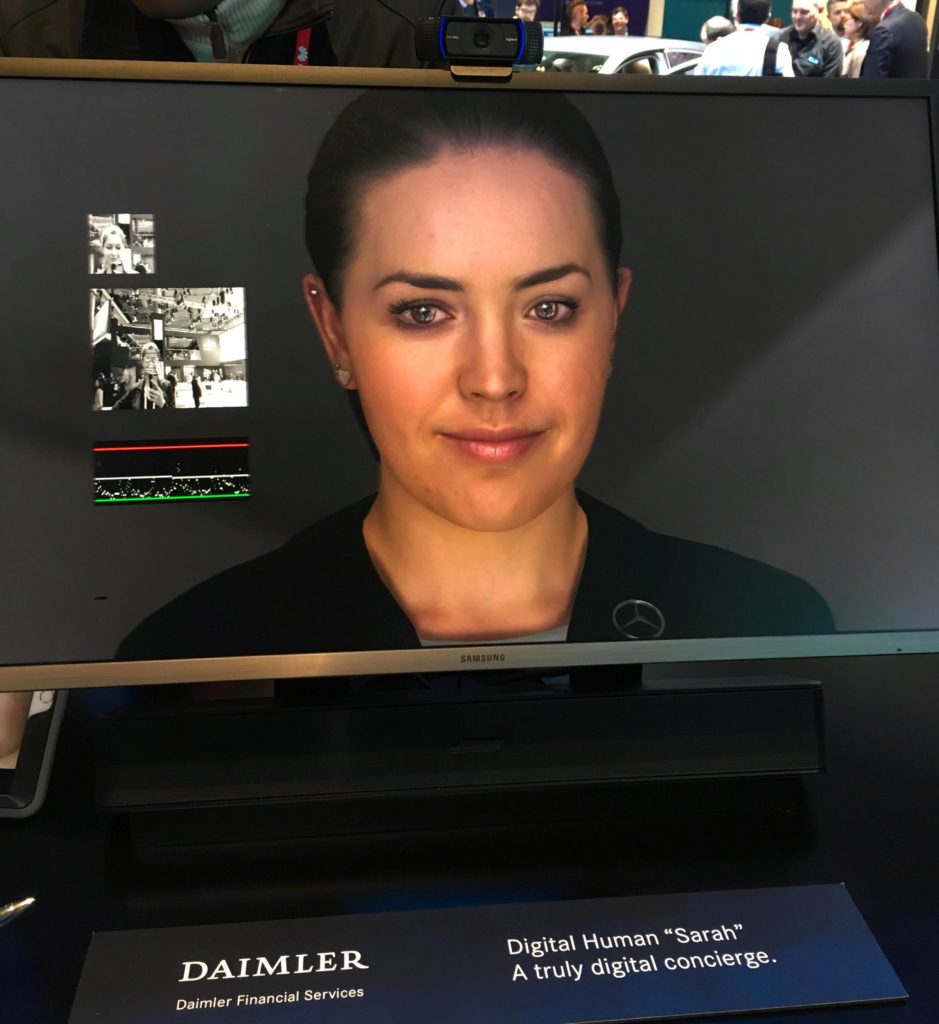
This is “Sarah.” On the surface, this is a CGI assistant, confined to a screen (temporarily I’m sure) but incredibly realistic in its appearance and movements. Her image was created from a real human model and the model’s imperfections such as blemishes and scars were left which adds even more realism and humanity to the render. But the impressive quality of her physical appearance isn’t the most interesting thing – the slightly disconcerting magic happens in how she interacts with the viewer. There is a camera on the top of the screen which identifies exactly where the viewer is looking and what facial expression they are making. The CGI face then reacts to this information in real time. She moves her head and eyes to look at you as you move around and she responds to your facial expressions with her own. If you smile, she smiles. However, if you frown she doesn’t frown back. Her human guide explained to me that they decided it wouldn’t be productive if she got angry in response to a customer’s anger. That would only lead to heightened tensions and potentially conflict. So instead, she becomes calm in the face of negative feedback with the aim of diffusing the situation (although admittedly this break from realism is somewhat off-putting).
At the startup branch of the event there was another booth that showed a closer look of what’s probably going on inside the “mind” of this type of interactive assistant.
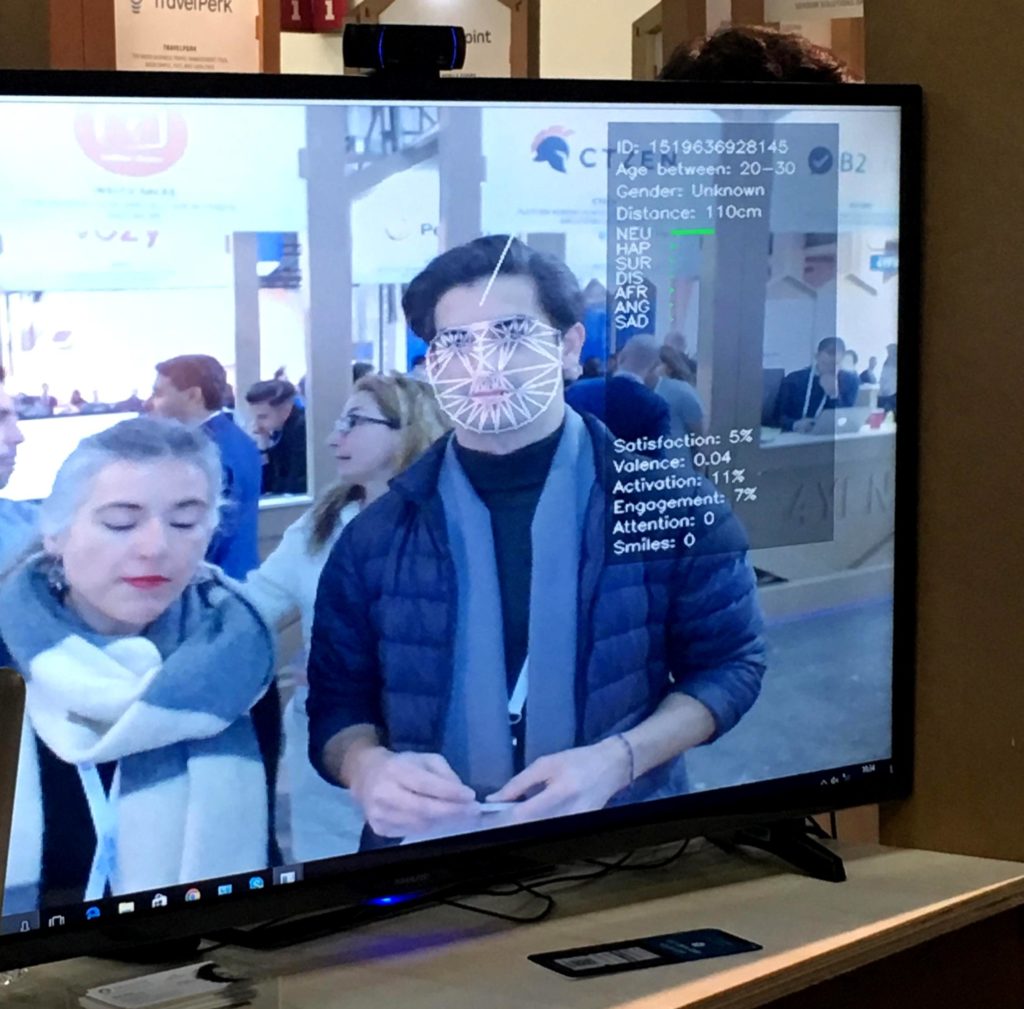
Basically, a camera films the human viewer/customer’s face and the software overlays a grid on it with lines connecting all the main features of the face such as eyes, eyebrows, nose, mouth, etc. When the human viewer makes an expression, the lengths of the lines between all the features change to reflect the new proportions. The changes in lengths communicate to the software what expression is being made and to what degree. On the screen you see a dynamic report of the viewer’s real time expressions as well as information about their identity. Are they male or female, young or old? What % attentive, angry, happy, etc. are they? Do they appear satisfied, engaged or maybe violent? How many times do they smile? The craziest thing is the accuracy and detail of the report. So much more often than we realize, we’re an open book, and smart devices are becoming avid readers. Everything the computer learns about the viewer is written out on the screen and tagged with a unique ID, then (most likely) neatly stored away somewhere for future analysis. This software, when combined with realistic CGI such as “Sarah,” who can react to all this viewer feedback data in real time, creates a highly human-like interaction. Soon enough AI won’t only tell you what you want to hear from a cylinder on your desk, it will look at you and smile at you, making you feel like it’s truly listening to you and responding to your emotions in the same way a human would.
I had thought this level of realism was still in the world of fiction, but clearly that’s not the case. Technology is moving so fast these days than if you can dream it, someone is probably already building it.
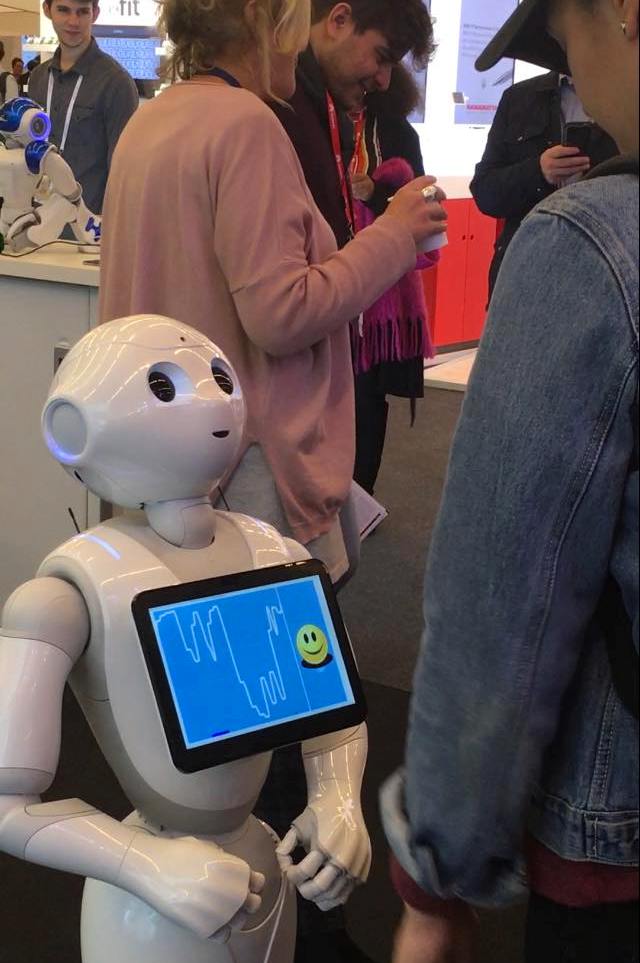
3. Anthropomorphizing robots
Another interesting thing I noticed was about the “likeability” of robots. Robots designed to look human or that are somehow humanized, with faces and arms and legs, are creepier than robots which appear simply functional with clunky disembodied arms. I even found the latter type to be cuter in a way than those actually intended to look cute with big anime eyes and cutesy gestures. I preferred watching the simple block clamps at the end of robot arms gently pick up pieces of a puzzle and organize them carefully in the correct order than the child-like robot (pictured) flash its colorful eyes at me, trying to elicit and “awww.” R2-D2, one of the most beloved cinema robots, had no resemblance to a human and was nevertheless as charming as any of its human counterparts, and often moreso. Apparently, it’s not necessary for something to look like a living thing in order to make a connection with one.
This aversion to realistic or human-like machines isn’t unique to me – it’s a common phenomenon often called “Uncanny Valley” – a hypothesis which states that a non-human thing which appears very human-like doesn’t elicit familiarity and liking from human viewers, but is perceived as eery and often elicits feelings of coldness and revulsion.
I believe this negative reaction has to do with the aversion to being manipulated and to fakeness. “Cute” robots are designed to play at your emotions so you feel more drawn to them and want to interact with them (ie buy their owner’s products). This makes you feel manipulated by the company that owns them (and of course you are being manipulated, but ideally you shouldn’t feel it happening). Whereas functional robots are not designed to be seen or to be “liked”, they’re not meant to be pretty, so they aren’t trying to seduce you and are therefore more “genuine” in their behaviors. This also relates to people’s disapproval of fakeness. We know that the robot is not alive or genuinely seeing us, perceiving us and reacting to us, but rather a product of complex emotionless algorithms – so why try to make it seem like anything other than that? Why try to make it seem alive and sentient when it is not? This trend reminds me of some arguments I hear about vegetarian food – why try to make a tofu burger or a veggie hot dog when the two things are so different in terms of ingredients and flavor? With veggie meals, as with robots, it’s often good to “be oneself” and capitalize on what makes one unique instead of imitating something completely different and thereby highlighting the contrast.
Just Cool Things
Flip Smartphones
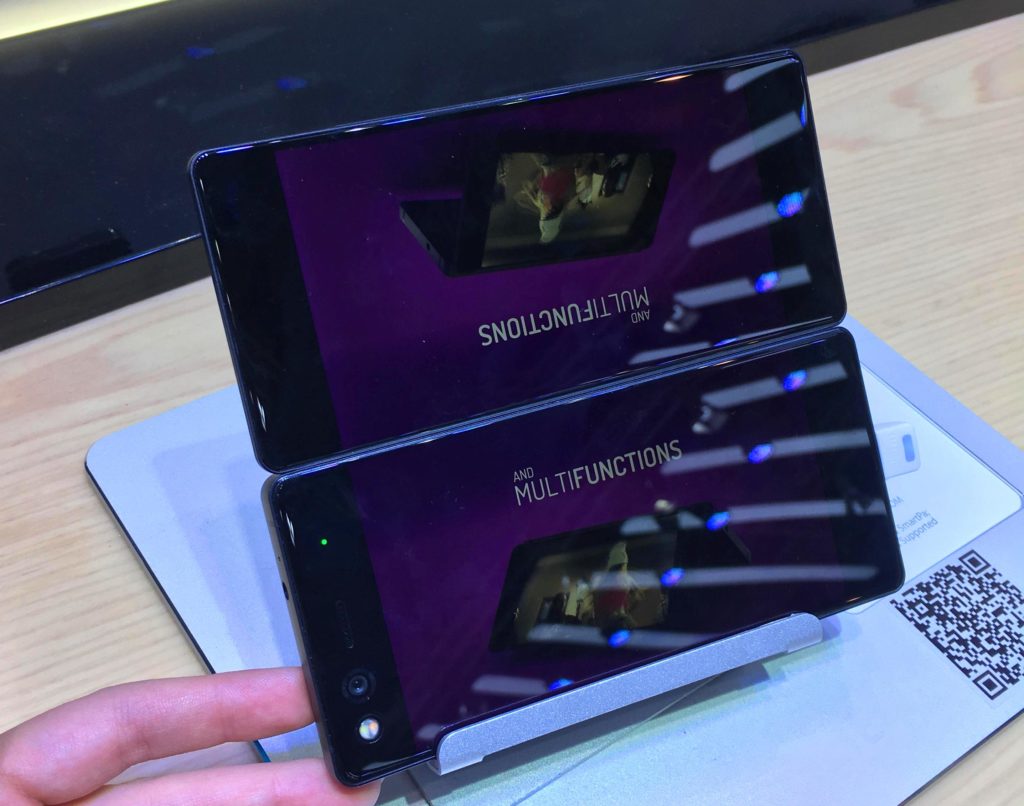
Blending the best of both worlds – the old passion for flip-able cellphones and the new love of giant screens and minimum volume – ZTE has created flip or “foldable” smartphones. The “cover” part is very thin with a high definition screen so that when you open it, the two screens make it so that it’s basically like watching a small television. When you close it, it’s hardly a different size from existing smartphones. Very cool.
Smart Textiles
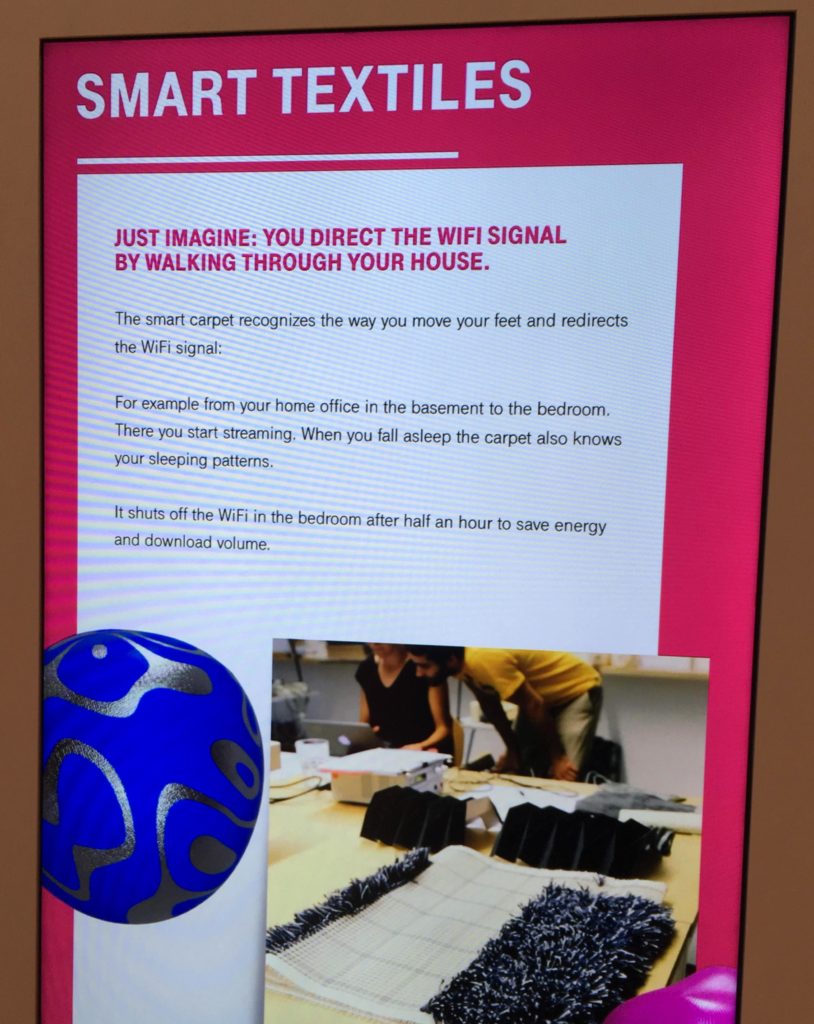
The blurb says it all – “Just Imagine – you direct the wifi signal by walking through your house. The smart carpet recognizes the way you move your feet and redirects the wifi signal.” Another idea was presented for “smart towels”: “Just Imagine – you log in to the guest wifi by using a towel. Hang it on a hook, a small LED lights up and you are logged into a guest account. The tile behind the hook changes colour and reveals a pattern you selected as a ‘visual key’ of the smartphone wallpaper during your last visit. A few days later when you leave, you put the towel in the laundry basket.” (Deutsche Telekom, MWC, 2018). Do I think this is over the top, unnecessary and could open users up to various security risks? Of course. Is it still pretty darn cool? Indeed.
3D Selfies
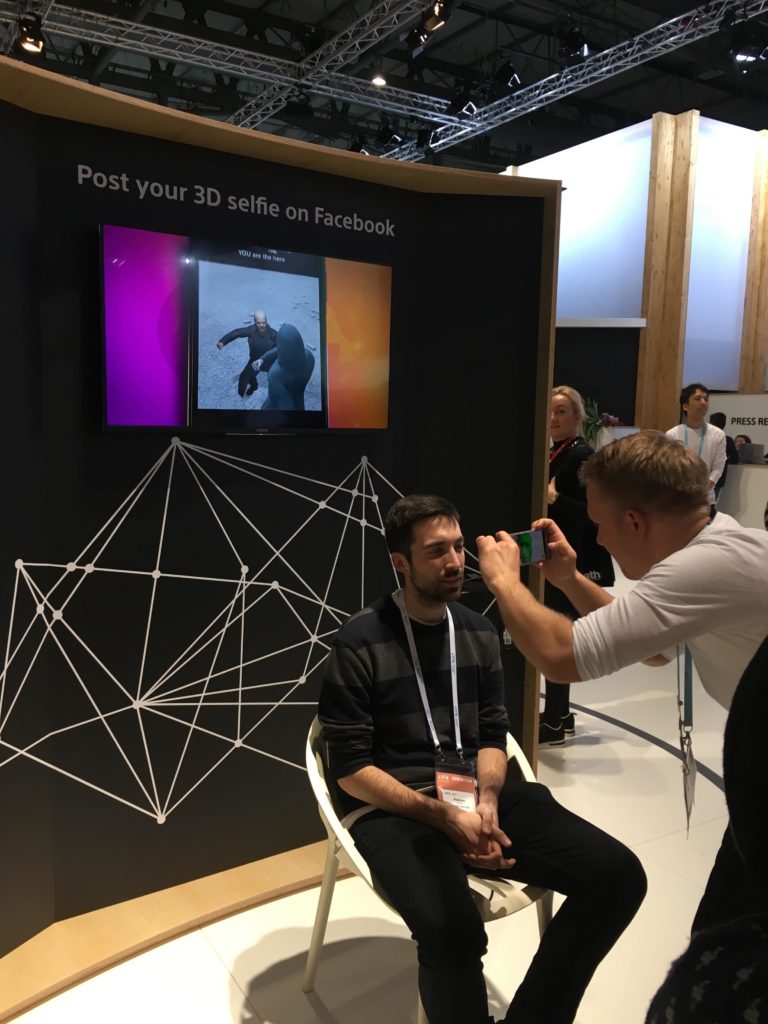
Capitalizing on our 21st century vanity and taking selfie-love to a whole new level, Sony Xperia now offers 3D selfies. If sharing only one perspective of your mug wasn’t satisfying anymore, now you can offer your audience the full 360! Basically, the “photographer” walks around the subject’s head and captures all the nooks and crannies of the face and head, which then show up on the interactive 3D, rotateable image. This 3D image can then be saved, shared and even posted to facebook. Aaah, the dream. Marty McFly didn’t see this one coming.
In summary, those are some of the things I found to be most interesting and memorable at the MWC 2018. The event was full of innovation, brilliance and creativity but it also had its fair share of head-scratching products and wacky ideas. Nevertheless, being there and seeing what’s at the cutting edge was an exciting and unforgettable experience. If you attended and saw something you’d like to share, or if you have any questions about the event, comment below or on the facebook page. Thank you for reading.




Recent Comments